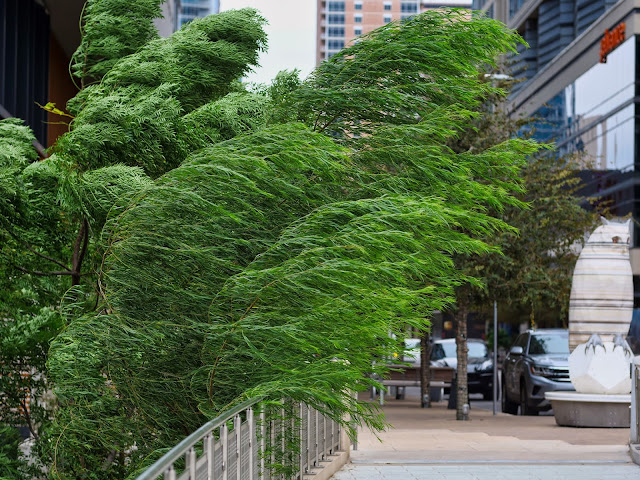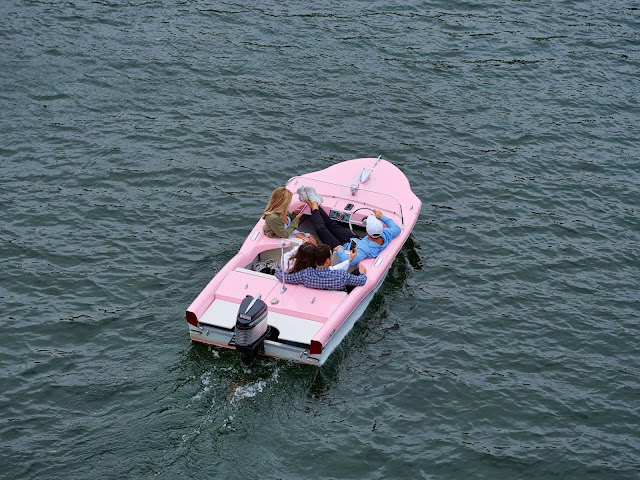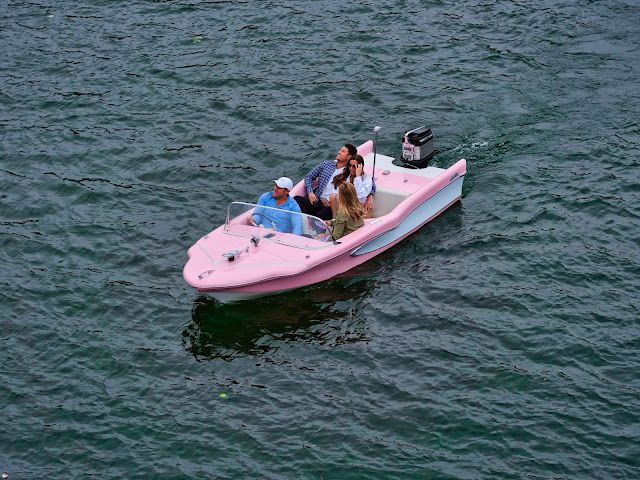I woke up this morning knowing that I was finished with Saturday's live concert video project. I'd double-checked the video footage from all three cameras we'd shot with then, archived it across a couple of HDs and prepped a third HD for my client to pick up from the studio yesterday. So, all done. Feeling of satisfaction. Stuff taken off my plate.
But the feeling of completion was short-lived. As soon as my brain registered that job "complete" it started working away on the next one. And, as I drove home from picking up more supplies this morning it dawned on me that, looking back over decades, the second most important thing we do on projects; after getting the assignment, is logistics.
Assembling the right gear is critical to commercial success. But that nearly always means more than just camera, lenses, batteries. And it's more than lights, and models. And assembling the gear is pretty much meaningless unless you also have a plan to deliver it to the right place. On time.
I realized in a flash this morning that for every minute I've actually spent with a camera in my hands, photographing a commercial jobs, I've spent at least an hour getting ready. It's odd to realize that you've spent much more time as a furniture mover and supply buyer than you will have ever spent actually making the art.
Today is a perfect snapshot of that. Tomorrow I start a two day shoot with one of my favorite national acting talents, Jaston Williams. He's producing a new play and his agent from L.A. reached out to offer me the job of photographing Jaston in a wide range of costumes and make-up. The photos will be used as content in the production and also for marketing. His production company has rented a large stage at one of the local theaters and we'll be shooting everything against white so we can drop out the background in post.
I wish I was a "famous" photographer with a devoted entourage and I could task someone else with all the stuff we need to do to get ready for a relatively straightforward series of photo sessions. But I guess I never developed the personality that would allow me to lounge about on the set with a martini in my hand while others do the work. Some day, maybe, but it hasn't jelled yet.
So, off my brain goes on the next game of "Be Prepared."
I start from the back of a set and work/plan my way up. We need to shoot on a white seamless paper background. I checked our current roll. It's tattered and has only a few yards of life left. I need a new roll. I head to the camera store and grab the last roll of "Super White" nine foot wide seamless and head for the counter. Then it dawns on me that this might be the first time I've stuck a long roll of white seamless in the new car. Will it fit? Yes. On the way home I start making a list of all the stuff I need just to make the background paper work.
I'll need to tighten the levers that lock in the sections on the background stands. That takes a Phillips head screw driver and a wrench. I need to pack two clamps to keep the paper from unrolling as we loft it. I need a roll of white duct tape to tape the front of the paper to the stage floor. I need a small knife to cut the paper out of its box and then out of its protective plastic bag. Also to slice off used paper if we decide to roll out more. I need two, white, shiny Formica panels to put on top of the seamless so the talent can stand on them without destroying the paper underneath. The panels are also easy to clean. Remember to bring shop towels and spray cleaner. All that stuff gets added to the inventory list.
Once the background gets figured out I work on the lighting. How will I light this so the background goes away but Jaston looks fantastic? Do I use flash or continuous lights? Well, we'll have a videographer in tow shooting BTS and also web content so flash is out. That means I need to bring a bunch of LED lighting to get the levels high enough to freeze action. I'll need four lighting instruments to make the background even and bright. I'll need four stands for those lighting instruments. I'll need some clamps and some Black Wrap to control light spill. I'll need reflectors and barn doors for those fixtures. I'll need an electrical cable for each unit and a "master" extension cable for the back four lights. With a splitter. Okay. Then I'll need a case to make transporting the lights and stands more efficient.
What about the front of the set? We'll need to light that as well.. I'll use a big, Godox SL200 Wii, as the main light, firing into a 48 inch octabox. That requires a stout light stand, a power cable, the actual octabox and access to yet another long extension cord. Oh, and a 30 pound sandbag. I'll also want to backlight Jaston so we'll need a heavy duty stand to hold a boom arm with a smaller light firing into a small, 32 by 32 inch soft box. We'll need a power cable for that as well as a speed ring for the soft box and....the soft box.
To even out the front light from top to bottom in the frame I'll want to put a shiny reflector on the floor in front of Jaston and aim a light into that. I'm not looking for a 1:1 fill from the bottom source but enough added light so that the costuming doesn't go too dark near the bottom. Add in another light, another stand (a short one), another speed ring, another small soft box, another electrical cable and a big, shiny reflector.
Since I'll be using the main light 45° to one side and 45° tilted down I'll want to have a fill light to boost exposure on the shadow side of Jaston. That means one more light, one more stand, one more cable, and one more modifier. To keep it simple I'll bring a medium sized, shoot through umbrella.
To wrangle all that light we'll need our light meter. I think I'll bring the Spectra Cine Pro 1800 meter, just for grins. It's the perfect solution for continuous-only metering. No flash mumbo-jumbo to get in the way.
The second set of lights (the front of scene lights) will also need a case for transporting as well as an additional stand case for the four other light stands and the boom arm. (I bet you already forgot about the boom arm....).
And that gets us to cameras. We'll keep this simple. We need high resolution and more resolution so we'll pack a Lumix S1R along with another S1R as a back up camera. Each camera travels with two batteries and each camera is loaded with a 128 GB SD card and a 128 GB CFexpress card. We'll bring the 24-70mm f2.8 S-Pro lens, the 70-200mm f4.0 S-Pro lens and also toss in the Panasonic 24-105mm S lens as a back up for both of the other lenses. Remembering to pack a bulb blower for dust on the sensor, lens cleaner, a micro cloth or two, and, of course, a case to hold the cameras lenses and accessories.
I'm thinking, given the large size of the stage, the lack of any close by electrical outlets, etc. that it's probably prudent to bring along four 50 foot, heavy duty extension cords along with splitter boxes for each. We have a box for those.
Finally, I need to bring along out cart to get all this stuff in and out of the building. No sense making a dozen trips in and out to the car if we can do it in two or three trips.
Logistics. After we unload the car I have to set all the stuff up and test it. Then, on Wednesday afternoon, after our two day project is wrapped at the location I'll pack all that stuff back in boxes and cases, cart it out to the car, drive it home and carry it back into the studio. We'll check all the lights, meters and cameras to see if anything needs batteries or maintenance and then start on the post processing part of the job.
Once I've got a handle on post processing I'll start pulling stuff out of travel cases and putting it back on the shelves and in the cabinets where it mostly lives.
At every step of the way it's the logistics of moving things in and out, remembering the little accessories that attach or power the bigger stuff, having the right materials, etc. I'm lucky on this job in that they have their own, dedicated make-up person and their own costume and wardrobe manager. There's a P.A. on set and, since the main production company is very professional there will be coffee.
I'll have Ben or another assistant travel to the theater in a separate car and help with with the load in and then again the next day with the load out. But I sure don't need an assistant to hang out with me all day long. Especially since I anticipate a lot of downtime for costume and make-up changes.
We'll have a tight turnaround on Weds. We finish shooting at 4 pm and start packing and moving gear to the car. I anticipate being back at the studio by five or five-thirty where we'll unload and then grab a different set of cameras (2 x S1s) repack the same lenses, and head back to the theater complex to photography that evening's show of "Songs Under the Stars." That's the outdoor concert series I've working on. The rest of the week is dedicated to post production with a little break for a location scout out at Luminex. But the Luminex shoot doesn't happen until the following week so I haven't starting worrying about the logistics on that one just yet. One at a time. I think that's the best way to handle stuff.
Looking back over 30 years or so I'm fascinated with just how much of my career has involved the logistics of packing and moving stuff. We did a project in Russia in 1995 that required cases full of Hasselblad cameras and lenses, cases of film and Polaroid and cases of lights and stands. We spent a couple of weeks shooting the Catherine Palace and the Alexander Palace and it was a quick reminder that handicap access was not on the radar at that time in St. Petersburg or Puskin. Just more layers to logistics.
It's all about packing and gear handling. Many times I dreamed of being a photojournalist instead. One Domke bag full of gear and some strange khaki vest with pockets. That and a passport.
But I think commercial work turned out to be more financially productive....
Life. All about regrets, lost opportunities and logistics. Always logistics.
Dammit. I forgot about the tripod. Now I've added that to the list....
Somewhere in there I'll make time for a 65th birthday celebration and a couple of swim workouts. Staying busy is energizing. Feels just like the old days.




































